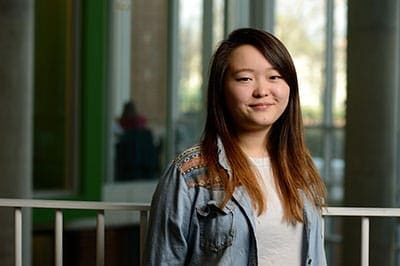Classes don’t usually make Lauren Berger nervous. As a sophomore, the international relations major has already successfully navigated her way through two years of demanding Hopkins lectures, seminars, final papers, and exams.
But a recent springlike afternoon found Berger walking down 33rd Street in Baltimore toward Greenmount Avenue with a Nikon D3000 in her hand—not a usual classroom experience. Her assignment? To photograph people walking, working, and shopping on a three-block stretch in this predominantly African American neighborhood; to engage them in conversation about the economy, their sources of pride, and their greatest disappointments; and to create photographic portraits that tell stories about race and class and politics.
"I’m not comfortable asking strangers for personal details about themselves," explains Berger, 20. And as part of a class of eight students, most of whom, like her, are white, she and some of her classmates worried about making the people they were photographing feel uncomfortable. However, by the time the group reached Greenmount Avenue, Berger was ready.
Working with two classmates, she spent the next two hours taking pictures of bow-tied bureaucrats and city bus riders, people working behind the counter at the beauty store and walking their kids home from school. She engaged them in conversations about everything from the lack of black-owned businesses on the street, to the political situation in Egypt, to President Obama’s economic policies. "I just don’t think this class would be as meaningful without these experiences," Berger says.
The class, Black Visual Politics—led by political scientist Lester K. Spence and photography instructor Phyllis Berger (no relation to Lauren)—requires photography, but it isn’t an art class. Instead it’s a traditional political science class addressing the politics of black families, the black self, and black spaces that’s combined with a documentary photography class. It’s interdisciplinary and collaborative. Over the course of the semester, students develop an artistic vision and create images in response to lectures and field assignments that are centered on the exploration of the role that images play in black politics. The new class was funded through a 2010 Arts Innovation Grant.
"I’ve always been interested in the power of images to promote and contrast ideas," says Spence, assistant professor of political science. Whether it’s through photographs of "welfare queens," he says, or billboards promoting marriage with dewy portraits of attractive, light-skinned black couples, images can convey emotions like deep disdain or feelings of crisis.
By asking undergraduates to read texts like The Souls of Black Folks by W.E.B. Dubois, and to critique images like Gordon Parks’ 1942 portrait of government char woman Ella Watson, while also creating their own images, Spence and Berger say their goal is to provide a complete picture of what black politics is, and how it works.
"When students make their own work, they really get a much deeper understanding of what they are looking at in popular culture," says Berger, supervisor of the photography program of the Homewood Art Workshops.
Students write papers and take photographs for the class, and their final project, worth 60 percent of their grade, is a 10-piece photo essay that explores a theme discussed in the course.
At a recent class meeting, students worked with their professors to critique a pair of self-portraits they created, one of their "black me" and one of their "white me." The images ranged from a duo depicting a size 9-1/2 hiking shoe and a sexy, black peep-toe stiletto, to a single image of two undergraduates, one black and one white, wearing fraternity sweatshirts that were identical except for their color. "I don’t see my black self as being different from my white self," says Max Dworin ’11, explaining his decision to shoot the photograph of himself (in a black sweatshirt) and his closest black friend (in a white sweatshirt) for his assignment.
The lecture that followed explored the concept of representation, focusing on both its explicit and implicit political elements. Spence projected two photographs, one of four nationally prominent African American politicians in suits and ties, and a second image of the hip-hop artist Nas dressed in a baseball cap with the word "Queens" on the front and a T-shirt printed with a racial epithet. Who did the people in each image represent? What did the word "represent" mean? And what are the political consequences of each image for populations labeled as "black"? Spence asked. The lively discussion connected elements of visual politics (the way black men pose in pictures), with rhetorical politics (the language blacks use in private), and electoral politics (the decision to vote or to abstain from voting).
"I really like how open this class is," says Nicole Petefish ’11, an anthropology major. "You can really say what you want and there’s no judgment. It’s observational. It’s scholarly. And it’s not just sitting around and talking. You have to go out with an artist’s eye and be creative and share with other people."
Dworin, an international relations major, took the class because he’s interested in a political career and was drawn to the idea of "dealing with race in a hands-on way." What he didn’t expect was how the photography aspect of the class would cause him to begin noticing things he had never noticed before.
Just the other day while driving in the city, Dworin saw an older African American man fashionably dressed in a plaid suit and hat, loading a large, dark red American sedan. Something about the scene caught his eye. "It just screamed old-time Baltimore to me," he says. Dworin reached for his camera, but when he realized he didn’t have it with him he was instantly disappointed. "Wow," he thought. "I wish I could take this photo."




